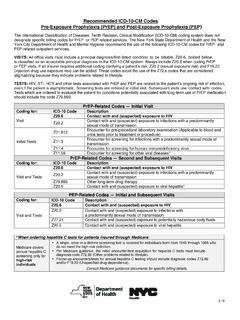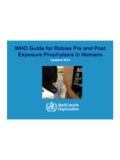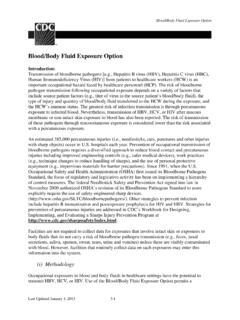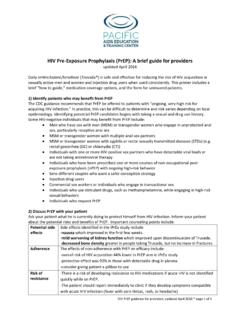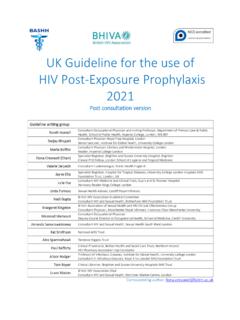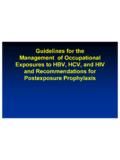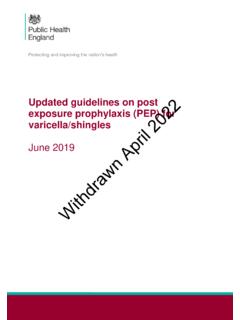Transcription of Guidelines for Blood-borne Pathogen Exposure and Post ...
1 UW Global Health Institute Guidelines for Blood-borne Pathogen Exposure and Post- Exposure prophylaxis in Global Health Field Sites Developed by Dr. Brian Jack and colleagues at Boston University Adapted with permission by Dr. Cynthia Haq for the UW Global Health Institute Last Reviewed by Dr. Frank Graziano, April 2010 Purpose The purpose of this policy is to delineate recommended actions that should be taken in case of an occupational Exposure of any member of the UW Global Health Institute to infected or potentially infected bodily fluid. The policy extends to faculty and also to clinical volunteers.
2 The policy can also extend to non-clinical students, staff or faculty if they should experience an Exposure , occupational or otherwise. This policy outlines the recommendations of the UW Global Health Institute (GHI). It does not replace individual choice. Each exposed person has the right to weigh the risks and benefits and make their own choice about when to take post- Exposure prophylaxis (PEP). Policy All lead faculty and participants of GHI field programs will be given a copy of this policy and requested to be familiar with it ahead of time in case a potential Exposure should occur.
3 Exposure to Blood-borne pathogens will be avoided as much as is reasonably possible, as outlined by Universal Precautions policies. Should a potential Exposure occur, immediate action will be taken to protect the exposed person. Starter packs of PEP medications, along with a copy of this policy, will be readily available to GHI lead faculty. Access to counseling and a medical visit with an HIV specialist will be available within less than 3 days and a regular follow-up schedule of visits and testing in recommended. Likewise, risk of hepatitis B infection will be prevented by vaccination but, if for whatever reason vaccination has not been done and immunity is documented, options for the reduction of transmission risk will be offered.
4 Records will be kept of any event of potential Exposure and the outcome. Program members taking PEP will be encouraged but not required to share the information about the course of their PEP and the final outcome for the record. Those who prefer not to take PEP when it is recommended by this policy will be asked to sign a statement of informed consent to decline PEP. Reduction of Risk All members of the GHI field programs, including clinical faculty, residents, and clinical volunteers, are required to have a full course of vaccination against hepatitis B. If possible, antibody titers should be obtained to prove immunity.
5 It is highly recommended that all members, including faculty, residents, and clinical volunteers, be tested for HIV on a yearly basis regardless of personal risk factors. It is also the policy of the GHI that all members should use universal precautions when potentially exposed to blood or body fluids. PEP Background Information Definition of Exposure Occupational Exposure is defined as any contact with an infectious body fluid as a result of an injury with a needle or any other sharp instrument, or via mucous membranes or an existing cutaneous condition (wound, eczema, scratch, etc.)
6 Non-occupational exposures to infectious body fluid may also occur, such as in the case of unprotected intercourse or blood Exposure during a motor vehicle crash. A potentially infectious body fluid that comes from a person who carries an infection is termed infectious. Potentially infectious body fluids include: blood, CSF, synovial fluid, pleural fluid, pericardial fluid, amniotic fluid, semen, or vaginal secretions. Non-infectious body fluids include feces, nasal secretions, saliva, sputum, sweat, tears, urine, and vomit, as long as these are not visibly contaminated with blood.
7 Risk of Infection due to Exposure People are considered to be at risk of infection from hepatitis B, hepatitis C, and HIV as the result of an occupational or non-occupational Exposure . The average risk for HIV transmission after a single percutaneous Exposure to HIV-positive blood is low (see table 1) and this risk is considerably lower than that arising from hepatitis B and C viruses (respectively 100 times and 10 times less). The risk of transmission of HIV due to intercourse is summarized in table 2. There is also a risk, although a lower one, of transmission of any other infectious agent present in the blood (hemorrhagic fevers, trypanosomiasis, etc.)
8 Factors of the Exposure that are associated with higher risk of HIV transmission are a percutaneous injury with a needle that has been placed in a vein or artery of the source patient, a sharp that is visibly contaminated with HIV-positive blood, or a source patient with primary HIV infection or end-stage HIV. The HIV prevalence in some world regions is high. Estimates of prevalence in sub-Saharan African countries range from approximately 3% to 30% depending on what population is considered. The inpatient population is estimated to be roughly 50% HIV-positive.
9 Hepatitis B and C rates are often unknown. Definition of Post- Exposure prophylaxis (PEP) Post- Exposure prophylaxis refers to medications given to prevent infection after Exposure . The prophylactic treatment offers both benefit and risk to the exposed person (see table 3). This policy provides a recommendation about when to take PEP and describes how PEP should be administered but does not mandate that PEP be taken when recommended, or not taken when not recommended. The exposed person must be advised of the risks and benefits and make their own decision whether or not to take PEP.
10 Actions to Follow in Case of an Exposure : 1. The exposed person will stop what they are doing immediately and rinse/disinfect the exposed area. Percutaneous injuries should be allowed to bleed, and rinsed thoroughly in running water for 5 minutes. Mucous membranes including the eyes should be rinsed with saline or with water for 5 minutes. 2. Alert a GHI faculty member, as well as any other direct supervisor. Do not delay the rest of the steps while waiting for supervisor or faculty member. The faculty member will initiate the incident report. 3. Evaluate the mode of Exposure according to table 4.
